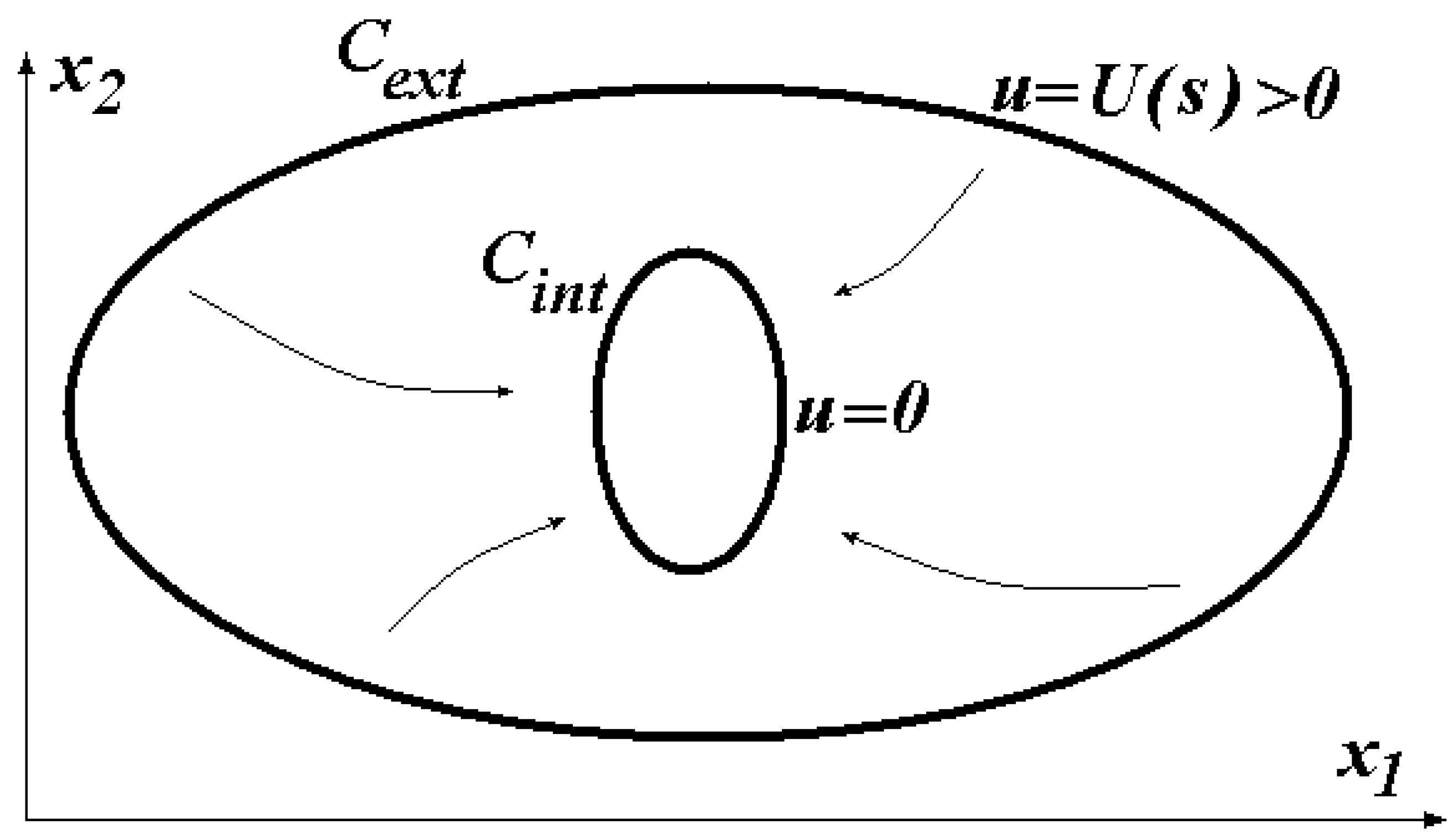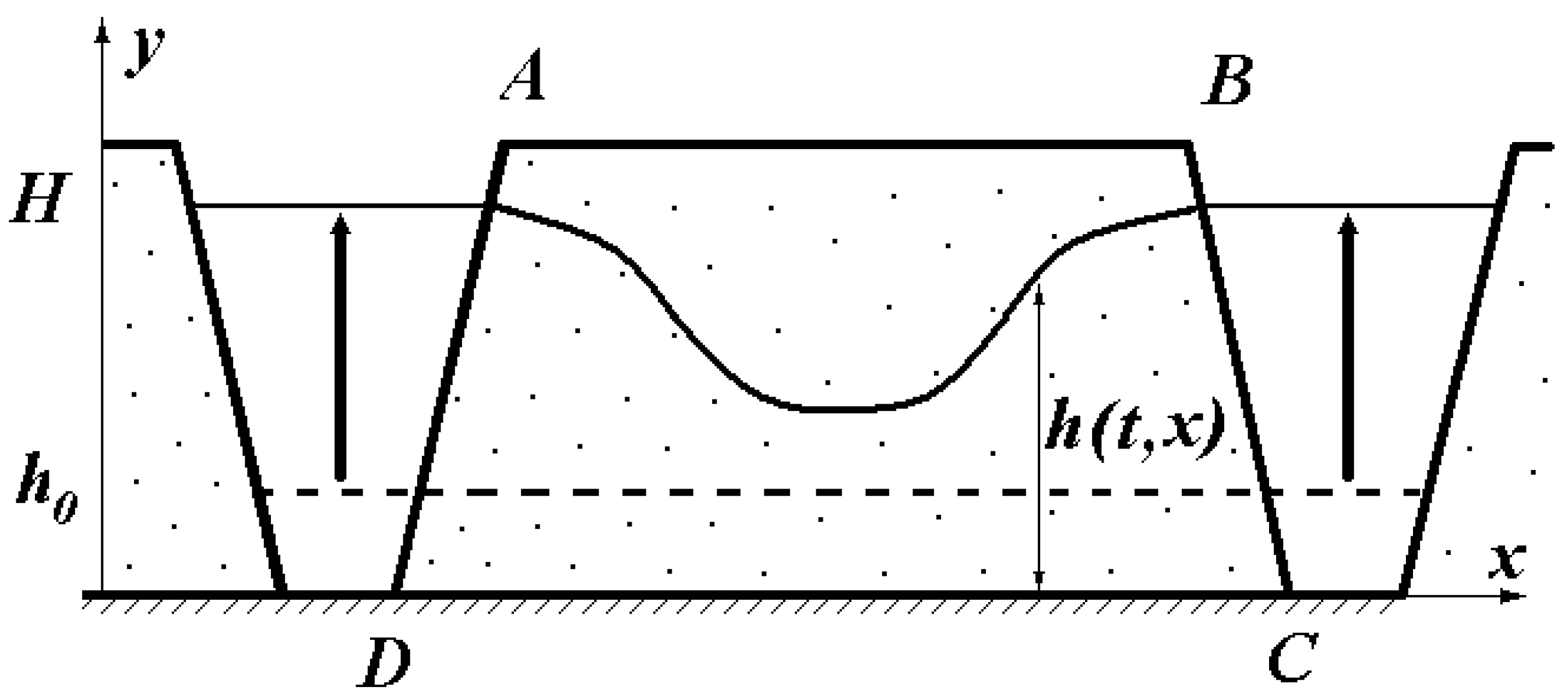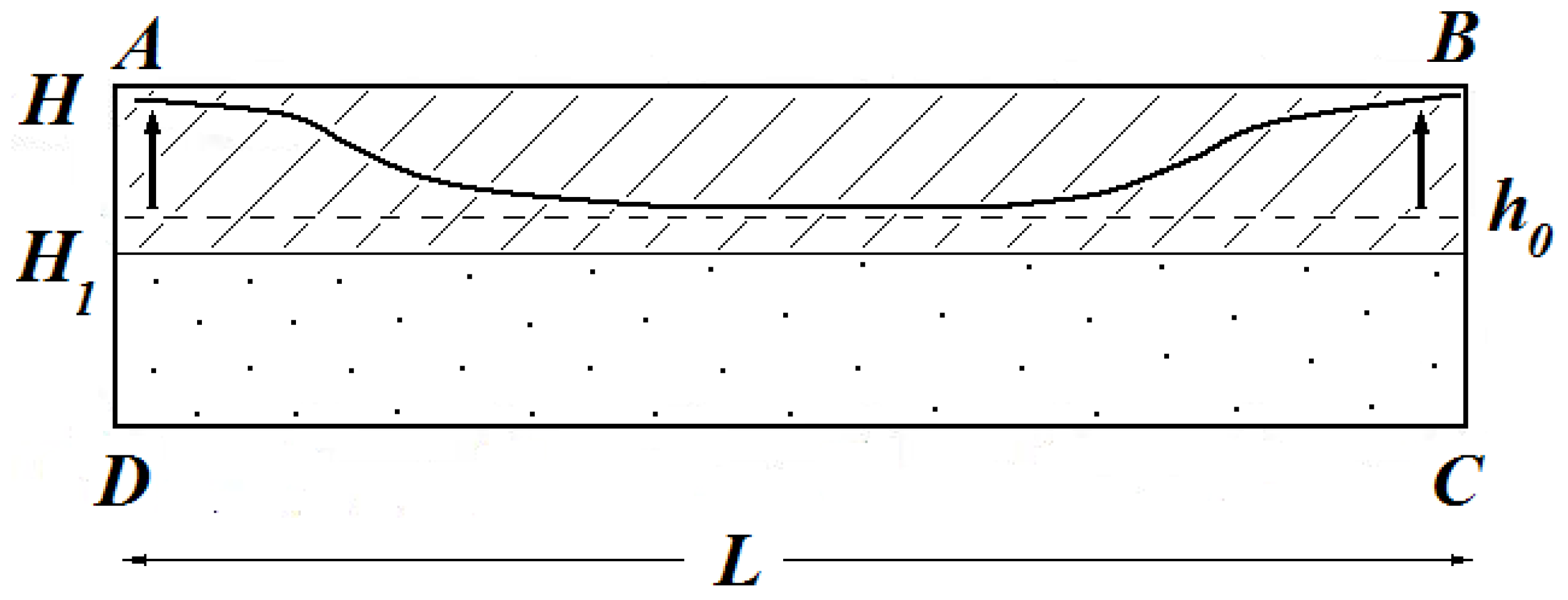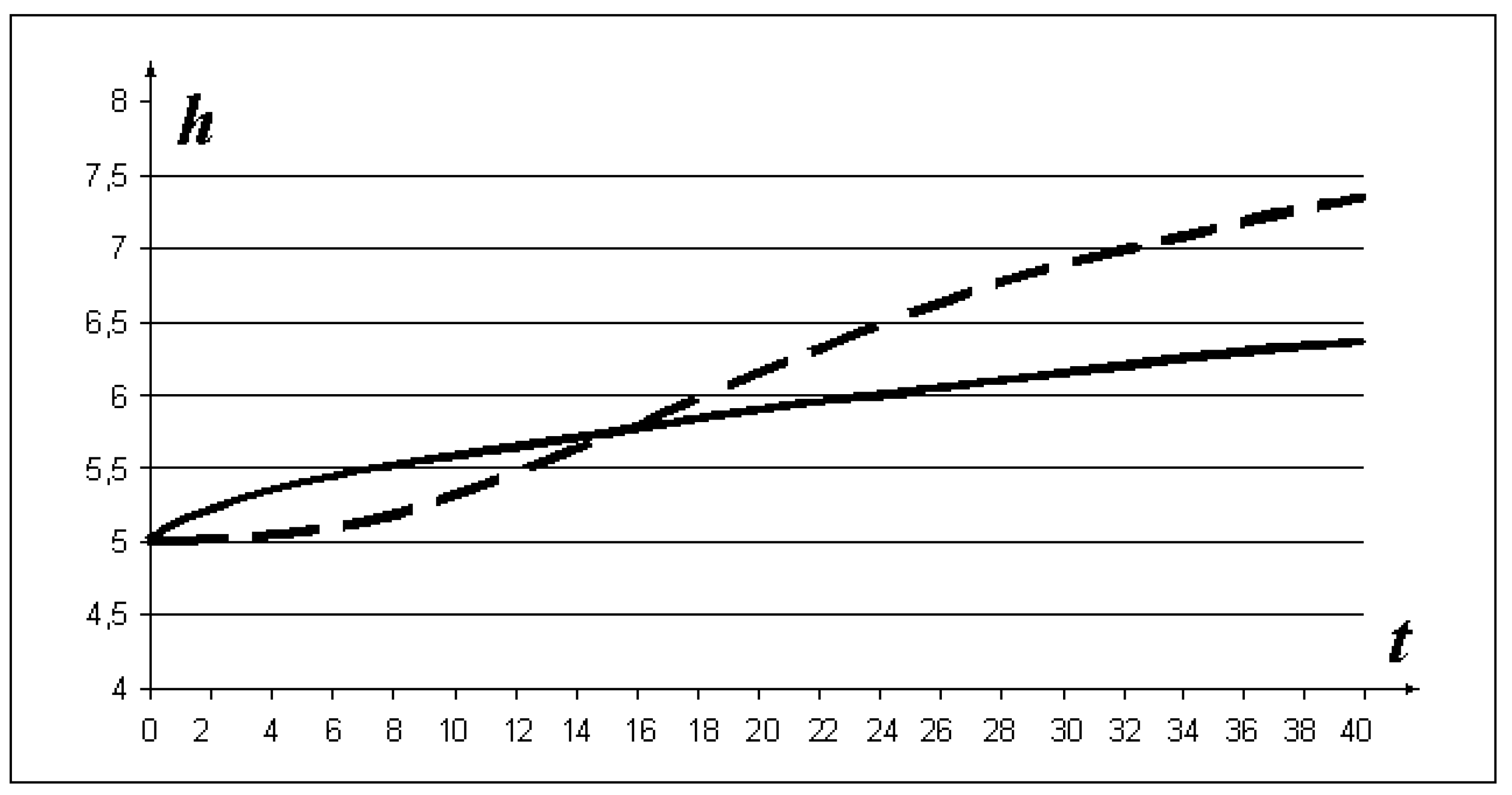3.1. The Proof of Proposition 1
We give a brief proof of the statements formulated in
Section 2.1 regarding the discharge from a confined aquifer into an open water body. We consider an anisotropic case with the distributions of transmissivity
and
assumed to be tensors, for which
everywhere in the domain
shown in
Figure 1. We denote the nonnegative difference between these tensors by
. For an auxiliary parameter
,
, we define a one-dimensional family of tensors
. At
and
, the tensor
coincides with
and
, respectively. The solution to the problem in Equation (1) with tensor
as a matrix of coefficients is denoted by
and the corresponding discharge value by
. Thus, the family of heads
satisfies the equations
Owing to the incompressibility condition, we have for the discharge value
where
n is the outer normal to the boundary of domain
.
Let us consider a problem, analogous to Equations (6) and (7), with a unit Dirichlet condition on the outer contour
of domain
. Its solution
satisfies the equations
Multiplying the second part of Equation (6) by
and integrating the product over the domain
with Equations (8) and (10) taken into account, we obtain the following expression for the discharge:
Finally, the differentiation of this expression with respect to parameter
yields the equality
because
, and the terms with derivatives of functions
and
with respect to
under the double integral in the left part of Equation (11) vanish after integration by parts in virtue of Equations (6), (7), (9) and (10).
If , then functions and are proportional and in virtue of the linearity of the problems in Equations (6), (7), (9) and (10). Now, the equality in Equation (12) yields , because the tensor is nonnegative. Therefore, in this case, we have , i.e., the discharge is monotonic with respect to transmissivity coefficients.
If, conversely, , the solutions of the problems in Equations (6), (7), (9) and (10) are not proportional, whatever the value of , and the gradients of those solutions, and , are nonzero and nonparallel on a set of points with a nonzero measure. This holds true, at least for small neighborhoods of the segments of the outer contour of domain , where , because, in these segments, the vector is perpendicular to the boundary, while the vector is not. For a fixed value of , for example, for , in all such points a positively defined matrix can be chosen, such that , while in other points we can set . Now, the inequality at will follow from Equation (12). Therefore, at sufficiently small values of parameter , the inequality will hold, while . This proves that the dependence of discharge Q on transmissivity coefficients is non-monotone in the general case.
If we limit ourselves to isotrophic distributions of transmissivity coefficients, i.e., assume the distributions
,
, and
to be scalar functions rather than tensors, then the above reasoning about the absence of monotonicity at
will require some supplement. Indeed, if the vectors
and
, though not parallel, form an acute angle with one another everywhere in
, then it would be impossible to choose a nonnegative scalar function
, such that the integral in Equation (12) be negative. This obstacle can be overcome by using the ideas of the homogenization theory of elliptic operators (see [
18]).
The main result of this theory is that, if the distribution of coefficients in Equation (1) has a fine structure with a small characteristic spatial scale (e.g., periodic in both variables with a period ), then the solutions of boundary-value problems at will be close to the solutions of analogous problems with some effective distribution , not depending on . In this case, the limiting distribution can be anisotropic, even if the coefficients in the original problems at any fixed are isotropic. Based on this fact, the absence of monotonicity can be proved in two steps. In the first step, a nonnegative tensor distribution is to be chosen such that the right-hand part of Equation (12) is negative at . This distribution can be anisotropic; therefore, the transmissivity tensor , for which the inequality holds for small values of , may also be anisotropic.
In the second step, we fix the value of parameter for which , and introduce a two-component composite medium consisting of two different isotropic media with transmissivities and where is a nonnegative scalar function to be found. To describe the distribution of both components within the aquifer, we consider a function which is 1-periodic with respect to and and, for any fixed , takes only two values, namely and . Let us take the transmissivity distribution of the above mentioned composite in the form where is a small parameter. At any point of the aquifer, the arguments are so-called fast variables. They are responsible for the micro-geometry of the composite in the -neighbourhood of this point. The transmissivities of both components and the geometric parameters of their distribution within periodicity cells are not assumed uniform overall the flow domain. The first pair of arguments in the expression for the function serves to describe slow variations of these macroscopic parameters within the aquifer. In approaches to the homogenization theory, such small-scaled composite structures are called locally periodic. In contrast with strictly periodic composites, the effective transmissivity tensor for them inherits the slow variations of macroscopic properties and depends on . The value of the effective tensor is determined by the microstructure of the composite, i.e. by the particular form of the function , which is not specified yet.
Let us denote by
and
the flow rates for the composite and effective aquifers, respectively. Then, in accordance with the homogenization theory,
converges to
as
. If, occasionally, the distribution of effective transmissivity
coincides with the distribution of
, then
. In this case, the inequality
will be valid for sufficiently small values of
. Since the composite medium is isotropic, it could be taken in place of the desired counterexample. Thus, it remans to construct a local geometry of the composite and find a nonnegative function
providing the prescribed values of the effective transmissivity
for any
and
. This is a typical inverse problem of the homogenization theory. In the case of two-component composites, it is thoroughly studied. There are different ways to provide desirable designs of the composites. One of them is given in [
19], and references for the others can be found there. Since the microstructure with the required properties is not unique, there is no reason to give here a precise description of a particular example of solution in explicit form. Right now, it is important that the microstructures with the required properties exist. This completes the proof of Proposition 1.
3.2. The Proof of Proposition 2
Here, we give a proof of the statement claimed in
Section 2.2 that the solution
to the inundation problem in Equations (2)–(4) with an arbitrary distribution of hydraulic conductivity
in the domain
is monotonous with respect to
K for sufficiently large
t. Clearly, at large times, the solution approaches equilibrium, in which
and
. Near the equilibrium state, we introduce new sought variables,
and
, and linearize the problem in Equations (2)–(4) with respect to them. In the linearized problem, the upper boundary of the flow domain is fixed and coincides with the horizontal segment of the line
between its intersection points with the lateral boundaries of
. In the new variables, the problem can be written as
with boundary conditions
Given the function on the upper boundary of the linearized flow domain, the mixed-type boundary conditions in Equations (14)–(16) are sufficient to solve linear Equation (13). The existence and uniqueness of such solution is guaranteed for any function which is continuous with respect to x and takes zero values at the ends of the upper boundary of the flow domain. This solution is linearly dependent on . Accordingly, the vertical component of the flow at the upper boundary of the domain can be uniquely determined by . Thus, a linear nonlocal operator is defined, transforming an arbitrary function into a function via the solution of the boundary value problem in Equations (13)–(16). In the mathematical literature, this operator is called after Lyapunov. Now, the remaining Equation (17) becomes .
As
depends on time only via function
, the linear operator
does not depend on time. Therefore, the non-stationary Equation (17) can be solved by Fourier method, by expanding its solution as a series in the eigenfunctions of the spectral problem
The properties of Lyapunov operator spectrum are well known (see, eg., [
20]). This operator is self-adjoint, and the problem in Equation (18) has a countable set of real eigenvalues
,
,
, and corresponding eigenfunctions
, which form a basis in the space of square integrable functions. Therefore, the solution of Equation (17) can be given as
where
are some constants, determined by the initial conditions. All terms of this series exponentially tend to zero at
, although with different rates. Clearly, at large time, the main contribution to
is due to the longest-living among these terms, which corresponds to the least
. The first eigenvalue
of the Lyapunov operator is known to be simple, so
, and the corresponding eigenfunction has a constant sign all over the interval of
x. Therefore,
, because the level of
at any time moment lies below the value of
H.
In the case of arbitrary distribution of parameters, the least eigenvalue
cannot be calculated, although some variational estimates can be obtained for it. For the least eigenvalue of the self-adjoint operator and the corresponding eigenfuction, the Rayleigh principle holds in the following form:
where integrals are calculated along the horizontal segment of the line
between its intersection points with the lateral boundaries of domain
, and the minimum is taken over all functions
from the domain of definition of operator
, which are not identically zero. The minimum is attained at
. A variation formulation also exists for the two-dimensional problem in Equations (13)–(16) in the flow domain. In accordance with Dirichlet principle, its solution minimizes the expression
over all functions
with square integrable gradient, which satisfy the boundary conditions in Equations (14) and (15). The remaining boundary condition on the aquiclude in Equation (16) and Equation (13) are satisfied in the flow domain for the function that minimizes this expression, and these conditions are necessary for the existence of extremum. In the minimum, i.e., for the solution of the problem in Equations (13)–(16), the expression for
can be reduced by integration by parts to become
because
and
at
. As a result, the Rayleigh principle (Equation (20)) takes the form
where the minimum is taken over all functions
that satisfy the boundary conditions in Equation (14) on the lateral sides of the flow domain and are not identically zero.
The obtained expression is convenient to construct estimates for the eigenvalue and, therefore, for the principal term of the asymptotic at of the solution to the problem of level recovery in Equations (2)–(4), as this expression monotonically depends on the distribution of the tensor of hydraulic conductivity . Indeed, for any fixed function , the greater is right-hand part of this expression, the greater is . Therefore, the minimal value of this expression over all possible functions has the appropriate monotonicity properties. If and are two different distributions of the hydraulic conductivity tensor, and , then the last variation equality yields the relationship for the respective eigenvalues. Now, from the presentation of the solution in Fourier series (Equation (19)), we have the inequality for sufficiently large t, which was to be proved.








